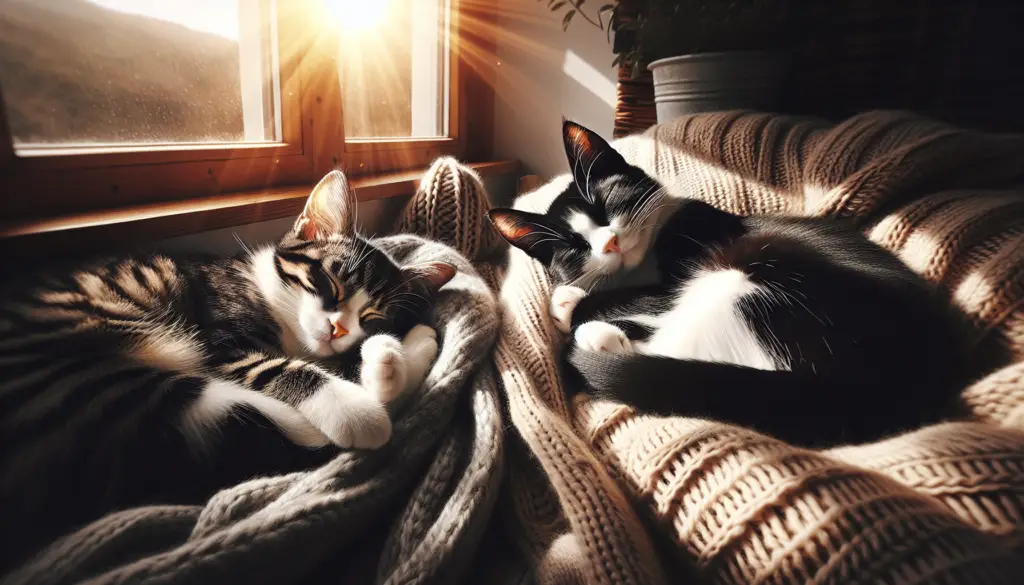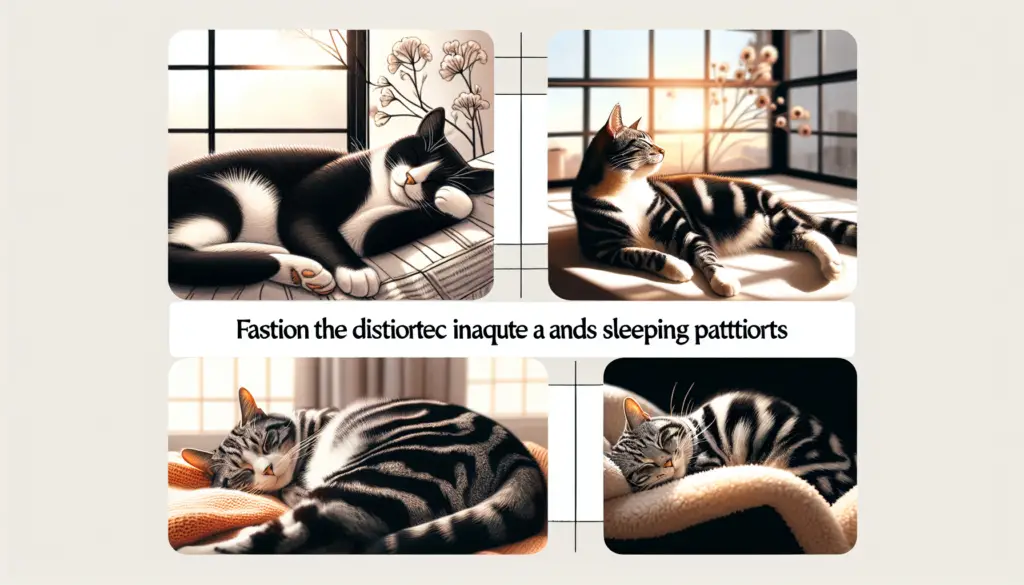Have you ever wondered about the sleeping habits of black and white tabby cats? It turns out that these adorable felines have quite interesting sleep patterns. From their notorious ability to nap almost anywhere to their seemingly endless hours of slumber, black and white tabby cats have a unique approach to getting their beauty rest. In this article, we will explore just how long these charming kitties sleep and what factors may influence their sleep patterns. So, get ready to enter the fascinating world of the sleeping habits of black and white tabby cats.
Sleep Patterns of Black and White Tabby Cats
Black and white tabby cats are not only known for their striking coat patterns, but also for their unique sleep patterns. If you are a proud owner of a black and white tabby cat, you may have noticed their tendency to snooze for long periods throughout the day. In this article, we will explore the intricate world of sleep in black and white tabby cats, covering topics such as sleep duration, factors influencing sleep, sleep cycles, sleep positions, sleep environment, dreaming and REM sleep, sleeping habits with other cats or humans, and how sleeping patterns change across different age groups.
Sleep Duration
Black and white tabby cats have a reputation for being champion nappers. On average, they can sleep up to 15-20 hours a day, which is significantly longer compared to other cat breeds. These feline friends have perfected the art of relaxation, and it’s not uncommon to find them peacefully dozing off in all sorts of cozy nooks and crannies around the house.
The prolonged sleep duration in black and white tabby cats can partly be attributed to their genetic heritage. Domestic cats, including the black and white tabbies, are descendants of wild cats, who also spent a significant amount of time sleeping to conserve energy for hunting. Additionally, factors such as age, health, activity level, and environmental conditions can influence variations in sleep duration among individual cats.

Factors Influencing Sleep
Several factors can influence the sleep patterns of black and white tabby cats. Age and life stage play a significant role in determining sleep duration and quality. Kittens and senior cats tend to sleep more than adult cats, as their bodies are growing or experiencing the effects of aging. Health and medical conditions, such as pain or discomfort, can also impact a cat’s sleep.
The activity level and exercise regimen of a black and white tabby cat can directly affect their sleep patterns. Cats that engage in regular physical activity and play are more likely to have restful sleep. Conversely, a sedentary lifestyle can lead to sleep disturbances or excessive drowsiness.
Environmental factors, such as the availability of cozy sleeping spots and the overall comfort of the surroundings, can greatly influence a black and white tabby cat’s sleep. Mental and emotional well-being also play a role, as stress and anxiety can disrupt sleep patterns. Lastly, diet and nutrition play a vital role in a cat’s overall health, which in turn affects their sleep quality.
Sleep Cycles
Like humans, cats go through different sleep cycles. Cats typically experience two types of sleep: rapid eye movement (REM) sleep and non-rapid eye movement (NREM) sleep. During NREM sleep, cats enter a deep sleep state where their body can rest and restore itself. REM sleep, on the other hand, is characterized by brain activity and dreaming.
Black and white tabby cats, like most cats, have relatively short sleep cycles that last about 30 minutes on average. Throughout the day, they can go through multiple sleep cycles, alternating between NREM and REM sleep. However, every cat is unique, and individual variations in sleep cycles can occur depending on factors such as age, health, and lifestyle.
Compared to other cat breeds, black and white tabby cats have been observed to have more frequent and longer periods of REM sleep. This indicates that they may have more intense dream experiences, though the exact content and purpose of these dreams remain a mystery.

Sleep Positions
If you’ve ever watched your black and white tabby cat sleep, you may have noticed the various amusing positions they assume. From the classic curled-up ball to the playful flop, black and white tabby cats have mastered the art of finding the perfect position for their naptime. These sleep positions are not only adorable but can also provide insight into a cat’s comfort level and sense of security.
Some common sleep positions for black and white tabby cats include the “loaf” position, where the cat tucks all their legs underneath their body, and the “bunny flop”, where they stretch out on their side with their paws extended. These positions allow cats to conserve body heat and protect vulnerable body parts. Additionally, the curled-up position helps cats feel secure, as it mimics the protective posture they adopt while grooming or resting in the wild.
Sleep Environment
Creating an optimal sleep environment for your black and white tabby cat is crucial for their well-being. Cats have their preferred sleeping locations, which can vary from perches and cat trees to cozy blankets or beds. It’s important to provide them with a comfortable space that allows them to feel safe and secure.
Temperature and lighting also play a crucial role in a cat’s sleep environment. Cats generally prefer a slightly cooler environment, around 65-75 degrees Fahrenheit (18-24 degrees Celsius). As crepuscular animals, cats are more active during dawn and dusk, so providing a quiet and dim sleeping area can help them settle into a restful sleep.
Disruptions or changes in the sleep environment can affect a black and white tabby cat’s sleep. Loud noises, bright lights, or unfamiliar smells can disturb their slumber, leading to restlessness or waking up during the night. It’s essential to create a calm atmosphere and minimize any potential disturbances to ensure a good night’s sleep for your feline friend.
Dreaming and REM Sleep
Have you ever wondered if your black and white tabby cat dreams? The answer is a resounding yes! Cats, including black and white tabbies, experience REM sleep, which is associated with dreaming in both humans and animals. During REM sleep, the brain is highly active, and the eyes move rapidly beneath the closed eyelids.
Although we can’t fully understand the content of a cat’s dream, observable signs such as twitching paws, whisker movements, or even soft vocalizations can indicate that they are in a dream state. Dreaming is believed to be beneficial for cats as it helps them process emotions, strengthen neural connections, and enhance memory.
Sleeping Alone or with Other Cats
Cats, including black and white tabby cats, are known for their independent nature. While some cats may prefer to sleep alone, others enjoy the company of their feline companions. It’s important to respect your cat’s sleeping preferences and provide suitable sleeping arrangements.
Cats are social animals and can benefit from the companionship of other cats when it comes to sleep. Sleeping together can provide a sense of security and warmth, replicating the bond they would have with their mother or littermates. However, it’s crucial to ensure that each cat has enough space and resources to sleep comfortably, as overcrowding can lead to stress or territorial disputes.
Sleeping with Humans
Black and white tabby cats often develop close bonds with their human family members, and many cat owners wonder whether it’s acceptable to share their bed with their feline companion. The answer ultimately depends on your personal preference and the individual dynamics of your relationship with your cat.
Some cats enjoy sleeping with their humans, finding comfort in the warmth and presence of their loved ones. However, it’s important to establish boundaries and make sure that both you and your cat are comfortable during bedtime. Providing a separate sleeping area, such as a cat bed or a designated spot on your bed, allows your black and white tabby cat to retreat if they need their own space.
Sleeping Patterns in Different Age Groups
Sleep patterns in black and white tabby cats can vary across different age groups. Kittens, for example, tend to have shorter and more frequent sleep cycles as their bodies are growing and developing. As they mature into adult cats, their sleep patterns become more consolidated, with longer periods of uninterrupted sleep.
Senior cats often experience changes in their sleep patterns due to age-related factors such as arthritis or cognitive decline. They may sleep more during the day and have difficulty settling at night. Providing a comfortable and supportive sleep environment becomes crucial to ensure their well-being.
Conclusion
Understanding the sleep patterns of black and white tabby cats is not only fascinating but also vital for their overall health and well-being. These unique and beautiful felines have their individual sleep needs, and it’s our responsibility as cat owners to create a sleep-friendly environment tailored to their preferences.
From their extended sleep durations to their adorable sleep positions, black and white tabby cats continue to captivate us with their one-of-a-kind sleep habits. By respecting and accommodating their sleep needs, we can ensure that our beloved feline friends are well-rested, content, and ready for their daily adventures. So next time you catch your black and white tabby cat in the midst of a snooze, take a moment to appreciate their remarkable sleep patterns and cherish the special connection you share.

